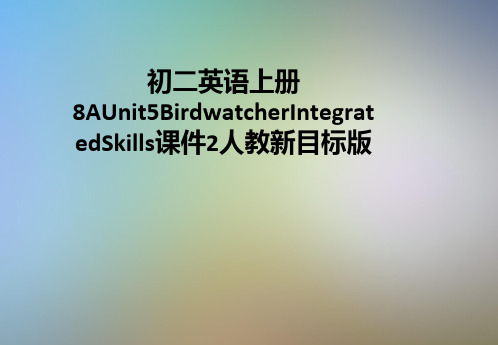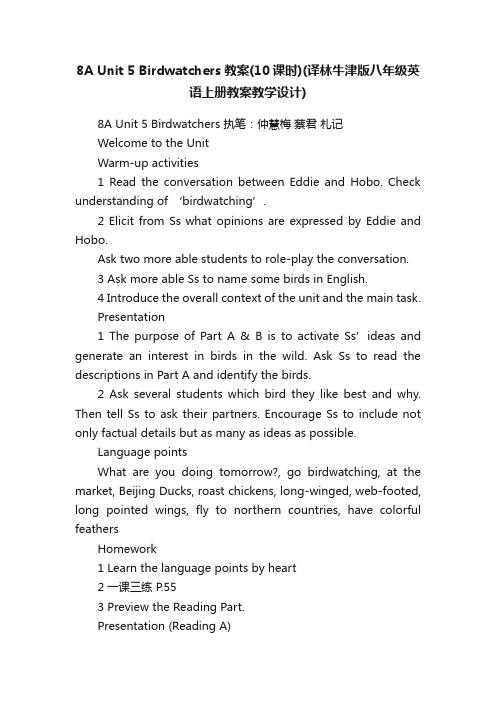8A Unit 5 Birdwatchers Intergrated skills20091014144216
- 格式:doc
- 大小:39.00 KB
- 文档页数:2


8A Unit 5 Birdwatchers教案(10课时)(译林牛津版八年级英语上册教案教学设计)8A Unit 5 Birdwatchers 执笔:仲慧梅蔡君札记Welcome to the UnitWarm-up activities1 Read the conversation between Eddie and Hobo. Check understanding of ‘birdwatching’.2 Elicit from Ss what opinions are expressed by Eddie and Hobo.Ask two more able students to role-play the conversation.3 Ask more able Ss to name some birds in English.4 Introduce the overall context of the unit and the main task.Presentation1 The purpose of Part A & B is to activate Ss’ideas and generate an interest in birds in the wild. Ask Ss to read the descriptions in Part A and identify the birds.2 Ask several students which bird they like best and why. Then tell Ss to ask their partners. Encourage Ss to include not only factual details but as many as ideas as possible.Language pointsWhat are you doing tomorrow?, go birdwatching, at the market, Beijing Ducks, roast chickens, long-winged, web-footed, long pointed wings, fly to northern countries, have colorful feathersHomework1 Learn the language points by heart2 一课三练 P.553 Preview the Reading Part.Presentation (Reading A)1 Before Ss look at this page, review vocabulary of wildlife and conversation previously taught.2 Write the title ‘Zhalong-A special place’ on the board. Ask Ss what they know about it. Ask where do you think it is? What kind of animals live there? Etc. . Encourage any contributions.3 Encourage Ss to visit some of the websites providing information about Zhalong before the lesson.4 Ask pairs of Ss to exchange information and opinions about the different materials they are studying.5 Ask more able Ss to look for names and descriptions of birds. Have a class feedback using Ss’ rese arch skills.6 Read the title and explain the context. Ask questions about why Ss think that Zhalong is a special place.7 Ask Ss to skim the text quickly,focusing on key words and main points only. Set a strict time limit and tell them in advance that they only have 8 minutes, for example, to read the text. Then ask volunteers to each read a paragraph to the class.9 Ask Ss to write a caption for each paragraph.Presentation (Reading B)1 Ask students to do Part B1 as a quiz.2 Divide the class into groups of six. Choose a group to start the competition. Ask what does ‘endangered’ mean? Set a time limit for each group to answer.3 In pairs, Ss read and complete the conversation. Invite some of them to read it in front of the class.Presentation (Reading C)1 Divide the class into teams of 4-5 students. Do Part C1 asa quiz. Set a time limit.2 Ask students to correct the false sentences.3 Encourage discussions about why a sentence is wrong in order to develop Ss’ deductive skills.Language points (Part A)A nature reserve, in north-east China, one of the world’s most important wetlands, wildlife, provide sth. for sb. ,different kinds of, all year round, for a short stay, there are many fish, catch them for food, the rare red-crowned cranes, change the wetlands to make more space for farms, less and less space for wildlife, have enough space, the Chinese government, protect these endangered birds, a lot tourists, members of our Birdwatching Club, study the different kinds of birds, the changes in their numbers, a bird count, the importance of wetlandsLanguage points (Part B)Areas of land with wet ground, areas of land for farming, a place to live or stay, in a dangerous state, a large number of, people who are traveling, be important forLanguage points (Part C)Find food easily, in other parts of the world, have enough space to live, the ideal home for many plants, fish and birds Homework1 Learn the language points by heart.2 一课三练 P.56-573 Preview the Vocabulary Part.Presentation (Vocabulary)1 Elicit some adj. with negative meaning, e.g., ‘unhappy’, ‘uncomfortable’. Write the word on the Bb and underline the prefixes. Explain that these prefixes change the meaning of an adj. from positive to negative.2 Before starting on Part A, revise the meaning of all the positive adj. Ask more able Ss to use the words to makesentences to check comprehension.3 Explain the context of Part B.4 In pairs, Ss select suitable adj. from Part A. Then ask each pair to compare answers with another pair. Check answers with the class as awhole.Language pointsA protected area, leave litterHomework1 Learn the language points by heart.2 一课三练 P.583 Preview the Grammar Part.Presentation (Grammar Part A)1 Talk to Ss about organizing a school trip.2 Ask Ss to think of a school trip they would like to join in the future. Try to find some ads to help them to choose an event.Write some questions on the Bb:* When does the walk/competition start/finish?* What time does the coach leave?* Where/When do we meet?3 Point out the u se of the time expression ‘tomorrow’.4 Elicit the use of the simple present tense to talk about future events.5 Explain the context of Mr Wu planning a school trip to Beijing Wildlife Park. Point to the timetable and ask questions.Presentation (Grammar Part B)1 Ask Ss What are you doing tonight? to elicit sentences with the present continuous tense.2 Elicit from Ss the use of the present continuous tense. Point out that when using the present continuous tense to talk about the future, we normally talk about future events which arescheduled for the immediate future.3 Carefully explain the context of Part B.4 Ask students to read the conversation on their own, trying to make sense of it without focusing on the tense. Then ask them to fill in the blanks.4 Ss read the conversation in pairs, checking the correct use of the verb forms.Presentation (Grammar Part C)1 Elicit from Ss some sentences with adverbs.2Write the adv. From the table on the Bb, ask more able Ss to underline the suffix ‘-ly’ in the examples and formulate the rule.3 Ask Ss to add more examples to each group of adj. in the table.4 Check answers with the whole class.5 Ask Ss to Complete ‘Work out the rule’.6 Ask Ss to read the article in Part C2 silently on their own first. Ask Ss to complete the article using the correct adv. From Part C1.7 Ask Ss to work in pairs and rearrange the words to complete sentences in Part C3.Language pointsReturn to school, at the entrance, sandwiches, greet us politelyHomework1 Learn the language points by heart.2 一课三练 P.59-603 Preview the Integrated skills Part.Presentation (Integrated skills A)1 Try to maintain Ss’ interest in birdwatching and Zhalong.2 Remind Ss of the article about Zhalong which they read in the reading section. Ask Ss if they remember any facts about Zhalong.3 Ask Ss to read the quiz and try to answer the questions from the memory and general knowledge.4 Explain that Ss will listen to a radio program about Zhalong. Play the recording. Students listen carefully and tick the second column of boxes as they hear it.4 Check the correct answers with the whole class.5 Ask students to read the report in Part A3 in pairs. Go through the words in the bracket.Presentation (Integrated skills B)1 Close the books and listen to me while I read the conversation. Ask students to repeat the sentences as they hear them.2 Ask students to practice the conversation in pairs and then change roles.3 Ask students to work in pairs and create another conversation by replacing the underlined words.Language pointsincludingHomework1 Learn the language points by heart.2 一课三练 P.613 Preview the Study Skills, Main task & CPresentation (Study skills)1 Brainstorm from Ss when people need to take notes. Read 2-3 sentences and ask Ss to take notes as a warm-up activity.2 Ask Ss what kind of notes are considered good.3 Explain the context of Part A. Ask students to do the taskon their own and then compare their answers with a partner.4 Elicit from Ss other short forms widely used in dictionaries or other written texts.5 Tell students to read them again.Language points (Study skills)For example, per centPresentation (Main task)1 Introduce the topic of joining an organization. If possible, find out about similar writing.2 Introduce the idea that people need to apply formally before they are accepted to join a club..3 Explain the context of Part A. Go through the application form and explain any unfamiliar or difficult vocabulary.4 Ask Ss to discuss their own details with a partner.Language points (Main task)Application form, date of birth,Presentation (Checkout)1 Ss do Part A on their own and compare their answers witha partner. Ask them to practice reading the conversation in pairs.Language points (Checkout)simplyHomework1 Learn the language points by heart.2 一课三练 P.62-643 Preview the Unit 6。

Unit 5 Birdwachers第一部分简要提示一、年级:八年级二、教学内容: 8A Unit 5 Birdwachers三、课型: Integrated skills四、教学目标1.知识目标:听懂有关扎龙及湿地的词汇及句型。
学会用适当的词汇及句型对他人发出邀请。
2.能力目标能够通过听读信息材料完成对一篇报告。
能够运用正确的方式对他人发出邀请并做出正确的回应。
3.情感目标根据所学内容,通过对扎龙自然保护区的认识进一步激发学生对大自然的热爱。
五、教学重难点通过听力的训练获取更多有关扎龙自然保护区的信息材料,根据信息材料成报告。
学会向他人发出邀请以及做出正确的回应。
第二部分教学流程Step 1 Pre-listeningT: we have known many things about Zhalong Nature Reserve. Today we will get more information about it. First, I want to know how much you know about Zhalong.T: Please answer these following questions.(问题见ppt)Ss: Students’ answersStep 2 While-listeningT: Good! Now here is a quiz about Zhalong. Can you find answers to these questions? Please open the book on page 86, if you know the answers, please put a tick in the correct boxes under ‘before you listen’Ss: Students read the quiz and try to find the answers.T: Can you find the answers?Ss No. we can’t.T: well. Let’s listen to the tape and put a tick in the correct boxes under ‘while you listen’T: Have you finished? Let’s check the answers.Ss: Students show their answers.T: Good job. I have another question to ask you. Please listen to the tape again and pay more attention to the answer.T: Now, have you found the answer to this question?S1: Yes. It can provide food and shelter for endangered birds and prevent flood.T: Good. The word ‘prevent’ means stop … from doing…please read it after me.T: Now, we have much information about Zhalong. Let’s look at them. (见ppt)Ss: Students revise the information.T: Now Sandy wants to write the report about Zhalong. Listen to the tape again. And help her complete the report with the information we have known on P87.Ss: Students listen to the tape and finish the report.T: Time is up. Have you finished? Let’s check the answers.T: Well. Let’s read the report together.Step 3 Post-listeningT: This time, please work in groups of four and introduce Zhalong Nature Reserve according to the information in this table.Ss: Student work in groups of four and introduce Zhalong.Step 4 Speak upTask one inviting people to go birdwatchingT: Today we have learned much about Zhalong. And become more interested in it. Would you like to go birdwatching with me?Ss: Yes.T: Now, I want to invite you to a place to watch birds. It is called Beijing Wild Park. Do you want to go with me?T: today, daniel and Sandy are also talking about it. Let’s open the book on page 97. read in pairs and think about these questions.Ss: Students read in pairs and find the answers to the questions.T: Time is up. Can you find the answers?Ss: Yes.T: Let’s check the answers. (见ppt)T: Good. It’s Sandy’s invitation. Do you know what things we should notice when we want to invite our friends?T: let’s read the dialogue together and find the things we should pay attention.T: Good. Have you found?Ss: Yes. (见ppt)T: That’s right. When we want to invite someone else, we should pay attentaion to these things. But how to response to an invitation? Here are some expressions for you. Please read them.Ss Students read the expressions.T: Now. let’s work in pairs and try to make a dialogue to invite your partner to go birdwatching. Ss: Students make a dialogueTask Two more events for students to choose.T: Good job. Here are events you can choose to invite your friends. Please work in pairs to make a dialogue.Here is model one. You can use your own information to complete it.Ss: Students work in pairs and make dialogues.小结通过本课的学习,我们对扎龙自然保护区有了更进一步的认识。



牛津译林版英语八上Unit 6《Birdwatchers》(integrated skills)说课稿一. 教材分析牛津译林版英语八上Unit 6《Birdwatchers》主要介绍了关于观鸟的知识。
本节课的主要内容包括词汇、语法、阅读理解和听说技能的训练。
通过学习本节课,学生能够掌握与观鸟相关的词汇和表达方式,了解一般现在时的用法,提高阅读理解和听说能力。
二. 学情分析根据对学生的了解,他们在学习过程中具备一定的词汇和语法基础,对于一般现在时已有初步的认识。
然而,在阅读理解和听说技能方面,部分学生还存在一定的困难。
因此,在教学过程中,需要关注学生的个体差异,针对不同层次的学生进行有针对性的教学。
三. 说教学目标1.知识目标:学生能够掌握与观鸟相关的词汇和表达方式,了解一般现在时的用法。
2.能力目标:学生能够提高阅读理解和听说能力,运用所学知识进行实际交流。
3.情感目标:培养学生对观鸟活动的兴趣,增强对自然环境的保护意识。
四. 说教学重难点1.重点:观鸟相关词汇和表达方式的掌握,一般现在时的用法。
2.难点:阅读理解和听说技能的提高,运用所学知识进行实际交流。
五. 说教学方法与手段1.教学方法:采用任务型教学法,让学生在完成任务的过程中掌握知识,提高能力。
2.教学手段:利用多媒体课件、图片、视频等资源,激发学生的学习兴趣,提高课堂效果。
六. 说教学过程1.导入:通过展示观鸟的图片,引导学生谈论观鸟的兴趣,自然导入本节课的主题。
2.呈现:教师展示观鸟的词汇和表达方式,引导学生学习并掌握。
3.practice:学生进行小组活动,运用一般现在时进行交流,巩固所学知识。
4.阅读理解:学生阅读文章,回答相关问题,提高阅读理解能力。
5.听说训练:学生观看视频,完成听力任务,提高听说能力。
6.总结:教师对本节课的内容进行总结,强调重点知识点。
7.作业布置:学生课后观鸟活动,增强对自然环境的保护意识。
七. 说板书设计板书设计如下:1.观鸟词汇:列出本节课所学的观鸟相关词汇。
8A Unit5 Birdwatchers (Vocabulary & Grammar)导学案8A Unit5 Birdwatchers (Vocabulary & Grammar)导学案学法指导先复习书本P80-85上的内容,了解本课时相关单词、词组和句子。
完成书上巩固作业,弄清本课重点,最后完成效果自测。
学习目标及重难点. 1.能理解句子结构,识记相关词组和句子。
预习导学重点单词/词组/句子见默写纸预习效果自测用所给词的适当形式填空。
1. The show _________ (start) at 8 p.m..2. __________ ( lucky) , he did’t hurt himself.3. His plane _________ (leave) at 9 a.m tomorrow.4. Amy’s party ________ (begin) at 6 p.m. next Sunday.5. We ___________ (have) hamburgers for dinner this evening.6. She is a ___________ girl. She often does everything _______________.(careful)7.It’s too ___________. Some children are playing ____________ .(noise)8. The ___________ man shouted to us ______________.(angry)9. Mr Wu is a_________ man. So he can help you do it __________.(good)10. It’s _________ that he didn’t tell us the time ____________.(clear)11、Little Tom is sleeping, so we must walk _______ (quiet) and talk ________ (gentle).12、English is widely used all over the world. Do you know the ____________ (important) of learning English well now ? 13、Let’s go ________ ( birdwatch ) this Saturday, shall we?14、Our train ________ (leave) at nine o’clock tonight. 15、We _________ (have) noodles for dinner tonight.写出下列句子分别属于哪种基本句型,把字母填入括号内。
8A Unit 5 Birdwatchers Intergrated skills
教学目标:
1.听录音,获取具体信息。
2.根据从录音中获取的信息完成报告。
3.学习邀请别人参加某项活动的表达方式。
4.学习如何对别人的邀请做出适当的反映。
教学步骤
Step 1. 复习
Step 2. 呈现
1.have a look at the rest about zhalong in part A1 on Page86.Answer as many
questions as you can .
2.listen to the tape and answer the following questions .
3. listen again .
4.阅读第87页A3部分报告,根据完成A2部分联系时留下的印象初步选择答案,了解短文大意。
5.播放录音,请学生核对答案。
6.集体朗读短文。
Step3.Speaking
1.播放录音,回答问题。
2.再次播放录音,请学生跟随录音机朗读。
3.分小组操练对话,要求使用新内容替换划线部分。
4.挑选机组学生表演。
Step4.练习
一.短语
1世界上最重要的湿地之一 2.一块20,000多公顷的地3.世界湿地日 4.其它更小的鸟
5.写一篇关于扎龙的报告
6.在中国东北部
7.动植物的理想家园8.在12月15日,星期六9.观鸟的好地方10.防止人们砍伐树木二.动词填空。
1.would you like ________(go) fishing with us .
2.Daniel invited me _________(come) to his birthday party the next Sunday.
3.Our school __________(have) a big football field .
4.Our trip starts at 9:30a.m and ____________(finish) at 4:30p.m
5.Let me ________(invite) my friends because I ________(have) a birthday party the day after tomorrow.
8A Unit 5 Birdwatchers study skills 教学目标:
1.学习记笔记策略。
2.学习使用缩略词和符号。
教学内容
1.记录重要内容
2.使用缩略词
3.使用符号
4.四会内容
词汇:rest kilometer degree dollar
教学步骤
Step 1. 复习
Step 2. 呈现
1.for example ____________
2.and the rest_____________
3.minutes ______________
4.second centimetre ___________
5.kilomtere _____________
6.number ____________
rmation _____________
step3.
完成A &B on page 88.
Step4.补充一些缩略词
1.note well ___________
2.that is ___________
3.hour___________
4.square metres___________
5.verb ____________
6.especially _______________
7.New Zealand ___________
8.somebody/somethoing ____________
ually ________________
step5.homework
1.智能训练
2.完成补充习题的相关练习。